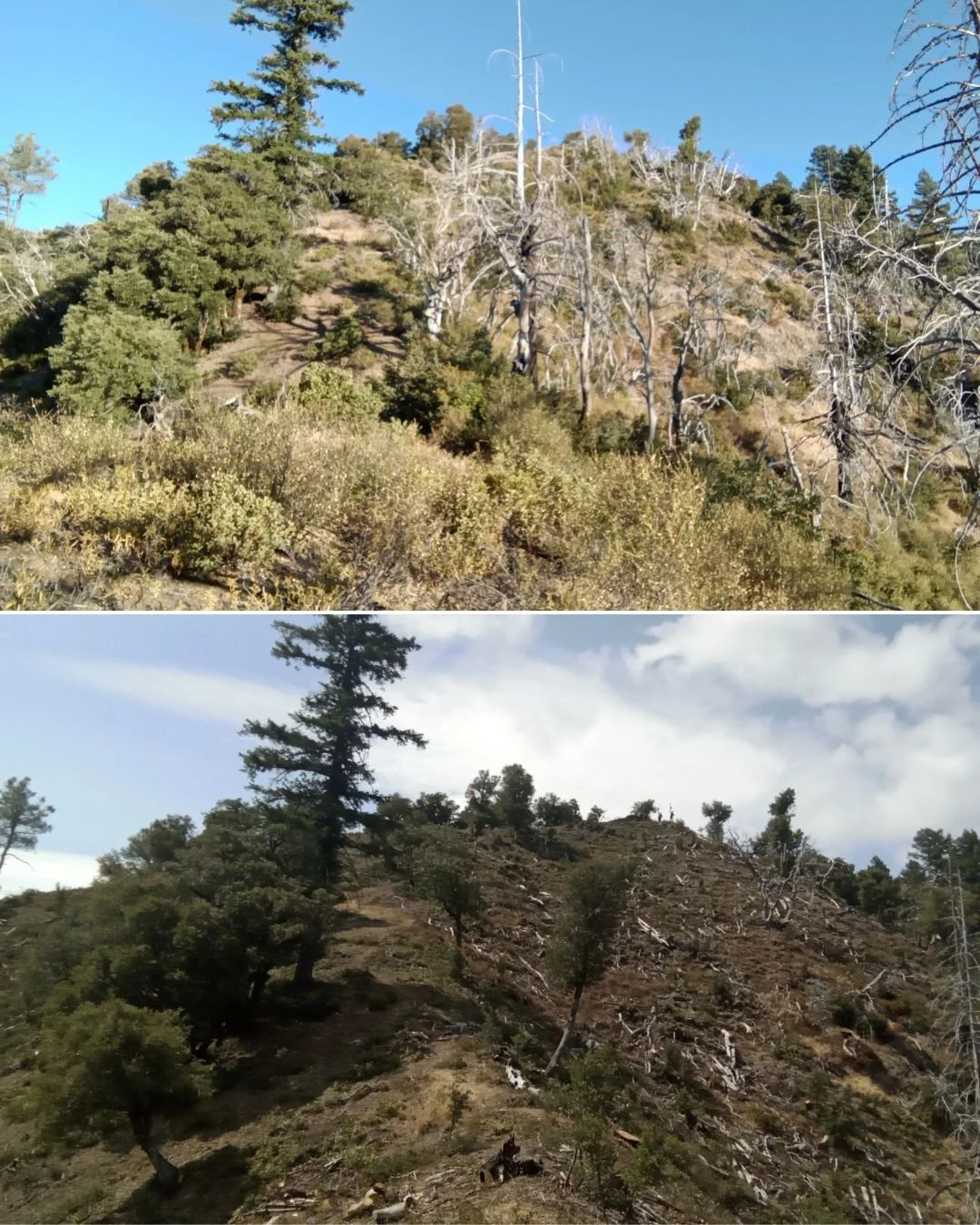Fuels Crews Maintain Mad Ridge Fuel Break, Improve Community Safety
Photo 1: Before and After treatment of the Mad Ridge Fuel Break, photo credit Charles Grippin
During a dry spell in November of 2024, the Watershed Research and Training Center’s (WRTC) Fuels Crews took advantage of the weather window to finish up work on a CAL FIRE Forest Health granted project, Trinity Community Protections Phase II. This work began in 2020 on the Six Rivers National Forest and has mainly included fuel reduction treatments along Mad Ridge, which boasts a 29-mile legacy fuel break that has functioned as a strategic feature for wildfire suppression between the communities of Mad River and Van Duzen for many years.
Fuel breaks are swaths of land where combustible vegetation, both living and dead, has been reduced by thinning trees and shrubs and limbing up branches to remove ladder fuels. This critical work creates anchor points of relative safety where emergency personnel can defend or burn to combat the progress of a spreading wildfire. The Mad Ridge Fuel Break is unique in that it follows the ridge itself, rather than a road, and includes a buffer 150 feet down either side of the rugged terrain.
Nancy Curran, former Fuels Forester with the Mad River Ranger District and one of the architects of the project, has been providing prescriptions on Mad Ridge and flagging units in the area for 20 years. She emphasized the importance of maintaining existing fuel breaks, highlighting the cost effectiveness of utilizing heavy equipment in past treatment areas. Chester Brown, WRTC Fuels Division Director, agreed stating that machines like masticators can cover twice as much acreage in a day during maintenance rather than construction of fuel breaks, reducing costs for mastication by up to 75%.
This past winter, hand crews were hauling their gear into terrain that no masticator could access, the Devil’s Backbone. This rocky outcrop is an incredible geological feature with 60% grade on either side of the ridge. Crews had to stay focused on safety and remaining sure-footed as they hauled equipment and fuel into the steep terrain. Once there, they thinned trees up to 12 inches to reduce the prevalence of fast-growing conifers, increase wildfire resilience, and encourage diversity of native plant populations. Curran emphasized the high quality of work that was completed under challenging conditions, emphasizing the importance of treating this difficult to access area to create continuity along the ridge.
Drone footage by Timothy Tremayne shows the WRTC masticator widening the fuel break in an expedient, cost-effective manner.
After finishing the Devil’s Backbone, the crews moved south to Jeep Road 6E01, where they performed detail-oriented hand work following machine crews who had come in to masticate and pile dense ladder fuels that had grown in after both the Mad River and August Complexes burned the area. Nancy applauded the hard work performed by all the crews involved, including sawyers from the WRTC, contracted tree fallers, and local heavy equipment operators, saying that the effort in logistics and hauling to access these areas was admirable and will make a meaningful improvement to the fire safety and watershed protection of both the Mad River and Van Duzen communities. Future work along Mad Ridge will be accessible by road and continue south toward Ruth.
Maintaining this legacy fuel break along Mad Ridge has been a collaborative effort that has included Joint Chiefs funding won in partnership between the Mad River Ranger District of the Six Rivers National Forest, the western side of the Shasta-Trinity National Forest, the Trinity County Resource Conservation District (TCRCD), and WRTC as well as implementation support from the Trinity County Resource Advisory Committee (RAC).
Cover Photo Caption: WRTC Fuels Crew Members Juan Martinez and Tony Minassian working on the Devil's Backbone in 2024. Photo credit Nancy Curran.

